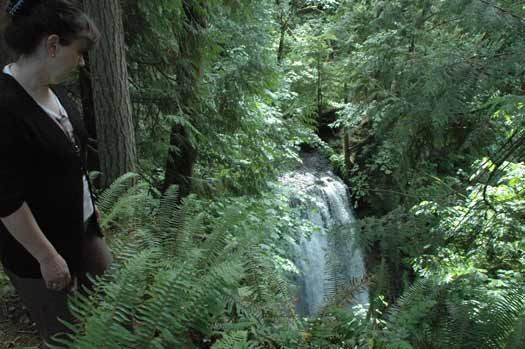Just off of Rhodes Lake Road, hidden behind a stretch of trees and one of the city’s wells lies one of the region’s hidden treasures: the 100-foot veil of water known as Victor Falls, connecting the upper portion of Fennel Creek to the lower Puyallup River system below.
It’s a gorgeous site, but like much of the eight-mile long Fennel Creek system, can be accessed primarily through private land, meaning it is either unknown to many in the city or at least out-of-site, out-of mind.
With that in mind, Bonney Lake resident and Fennel Creek Corridor Advisory Committee member Marion Betzer this past weekend organized a tour to allow access through some private property for views and a history lesson about Fennel Creek.
“It’s really hard to get to see Fennel Creek,” Betzer said, adding that the more visibility the creek gets, the better chance she and other concerned parties have of protecting the water way from development and other pressures.
The tour group of approximately 20 people, including three city councilmembers, county councilman Dan Roach and State Senator Pam Roach met Saturday morning at the Park and Ride lot and was whisked away to the home of Ken Love.
Love’s home is a former logging camp for a saw mill that used to sit at the top of the falls and he has access to a scenic overlook that he opened to the tour.
Along with the stunning views of the falls, the stop at Love’s home featured a short talk from Mike Scharpf, a fish biologist with the Washington Department of Fish and Wildlife.
Scharpf said while the falls provide a natural barrier to the salmon that live in the lower portion of the creek and the river system, the habitat and environment created by Fennel Creek and its watershed are helping fish populations below.
“Fennel is providing something the Chinook are enjoying,” he told the group, adding that the clean, cold water found in the creek are key to the trout that live on the plateau as well as the salmon below.
Scharpf said making sure the creek is shaded and running through wooded areas maintains temperature and food sources.
“Water flows downhill so anything that happens up here affects the water down there,” he said.
After the Victor Falls, the tour proceeded to a cul de sac in Sky Island, which provided a view on the western side of the Puyallup Valley and the Port of Tacoma and a stunning look at Mt. Rainier to the west, giving a view of the entire Fennel Creek watershed at a single time.
With Rainier as a backdrop, Rowan Schmidt of Earth Economics gave the group a small talk about the importance of protecting the environment as a way to ensure future economic viability.
“Today, economics understands that the environment is the big thing and the economy is a little thing that happens in it,” he said.
The next stop was at another private home, where the group wound through a trail in the woods to get a look at the creek as it flows on its way to the falls.
After lunch the tour headed back out with a stop at the Washington State Department of Transportation mitigation site on Old Buckley Highway, behind the Target.
The group received an overview of the work WSDOT has done at the site, both in 1993 and at the current site, as mitigation for the state Route 410 widening project. WSDOT is presently widening the creek’s flood area as well as adding habitat spaces, bat boxes and more than 86,000 plants.
The tour finished at Betzer’s home, which overlooks the Kelley Property from a ridge to the north, where Greater Bonney Lake Historical Society Member Winona Jacobsen provided a short history lesson of the area and the families that settled around the creek.
Betzer, the 2010 winner of the Robert Ceola Memorial Arbor Day Award, said she was pleased with the tour, which she has organized for several years and hoped the legislators and citizens who saw the creek would have a new perspective on preserving it in the future.
“It’s introducing us to what we have,” Betzer said.



